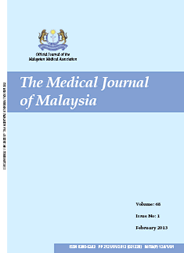MJM, Vol 70 Supplement 1 September 2015
Hospital cost of percutaneous coronary intervention
in Malaysia
*Ministry of Health Malaysia, **Department of Social and Preventive Medicine, Faculty of Medicine, University of Malaya, Kuala Lumpur, ***Department of Cardiology, National Heart Institute Malaysia, ****Department of Medicine, Faculty of Medicine, University of Malaya
ABSTRACT
Introduction: Coronary artery disease (CAD) is a leading morbidity and mortality in Malaysia. Increasing prevalence of CAD has led to wider use of percutaneous coronary intervention (PCI). Understanding its economic burden is critical for service expansion and resource allocation. We aim to describe the clinical and procedural characteristics of PCI patients at a cardiac centre and to calculate the hospital costs of PCI.
Method: This is a top down costing from healthcare providers’ perspective from January-June 2014 at a specialised cardiac centre. Patients’ clinical and procedural characteristics were extracted from the National Cardiovascular Database PCI Registry. Primary cost data was collected for overhead, asset, labour and consumables from the relevant hospital departments. Total cost of PCI is the cost of cardiac ward (CW) admission and the cost of cardiac catheterisation laboratory (CL) utilisation.
Results: During the study period, 301 patients were admitted and 333 PCI were conducted. At least half of all the patients had risk factors of CAD, namely male gender, smoking, dyslipidaemia, hypertension and obesity. Majority of patients were in NYHA Class I and had only one lesion requiring intervention. Out the 333 PCI, 77.4% were elective procedure. Single stent was used in 78.4%, and drug- eluting stents were the most commonly used type of stents. Success rate was high and only 3 procedures developed in-lab adverse events. In- hospital mortality was 1.3%, all 4 cases being emergency PCI patients. The average cost of a PCI was RM11,292. Average procedural cost in CL was RM9784, 86.6% of the total cost. Among the cost categories, PCI consumables were the major cost driver, followed by labour cost in the CW and CL.
Conclusion: This study provides important information on costs and cost drivers of PCI that can assist policy makers in future planning of PCI service.
